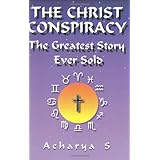
Average Reviews:

(More customer reviews)The further one goes into this book, the more one recognizes how vast is the mythological background of the ancient world that the modern era has completely lost sight of. Those who imagine that the Gospel story represents singular historical events are in for a shock when they realize the degree to which the Christian myth of Jesus of Nazareth was a reflection of mythical motifs and traditions which saturated ancient and even prehistoric cultures. There is barely an original or virgin bone in Christ's body, and Christians in the early centuries were regularly assailed by pagan detractors who accused them of reworking old ideas and copying from a host of predecessors.
The other thing the reader comes to recognize is that Acharya S has done a superb job in bringing together this rich panoply of ancient world mythology and culture, and presenting it in a comprehensive and compelling fashion. Moreover, she grabs the reader from the first page and doesn't let go. Her style is colorful, bold, occasionally (and justifiably) indignant, even a touch reckless at times, but never off the track--a little like an exciting roller coaster ride. It may take a fair amount of concentration to absorb all this material, but even if you don't integrate everything on first reading, the broader strokes will leave you convinced that the story of Jesus is simply an imaginative refashioning of the mythological heritage of centuries and that no such man ever existed.
She covers a wide range of interesting and provocative topics, with plenty of stimulating insights. Especially effective is her attention to elements of the Old Testament that one doesn't usually encounter in biblical studies: astrology in the bible, the mythological nature of much of the Old Testament material, the falsity of the idea that the Hebrews were monotheistic, even a chapter on Sex and Drugs. She delves into Egyptian and Indian precedents for the possible derivation of many of the bible's traditions. When she ranges even further afield and notes the astonishingly widespread commonality of certain religious and cultural motifs from one end of the planet to the other, extending back into very ancient times, we are on intriguing if speculative ground, but for the most part the author simply lets the data speak for itself, and readers can draw what conclusions their own adventurous spirits might wish.
As for her detailed picture of how Gospel elements closely conform to astrological and mythological symbols in the atmosphere of the time, or how the story of Jesus parallels the features of other savior gods: if even half of these things were in the minds of the Gospel writers when they fashioned their symbolic tale (to which one could add the midrashic borrowing of passages from the Hebrew scriptures to provide so much of the Gospel structure, its `events' and even their wording), there can be no doubt that such writers were well aware that their work had nothing to do with history.
There are those who have expressed some uncertainty about the scholarship which originally presented some of the subject matter dealt with in this book, since much of it comes from the 19th and early 20th centuries. But there is a prominent reason why today's researcher is inevitably thrown back on this early period of investigation. The so-called History of Religions School was a feature of that period, represented by such luminaries as Reitzenstein, Bousset and Cumont, and other, less famous scholars. Its conclusions about the relation of Christianity to the thought and religious expression of the time, especially in regard to the mystery cults and even solar mythology, proved very unpalatable to mainstream New Testament study. That was also the period of intense examination of the idea that no Jesus had existed at all (J. M. Robertson, Arthur Drews, the Dutch Radical School, etc.). The result was a backlash and a circling of the wagons, creating a fortress mentality against such scholarship for the latter three-quarters of the 20th century. As a result, there has been little recent investigation of that History of Religions material, especially sympathetic investigation. Acharya may draw to some degree on that older scholarship, but while certain aspects of it are necessarily a little dated, one of the things which struck me in her quotations from it (and more and more of it is now being reprinted) is how perceptive and compelling most of it continues to be. We sorely need a new History of Religions School for the 21st century, to apply modern techniques to this important ancient material. Perhaps this book will help bring that about.
Click Here to see more reviews about: The Christ Conspiracy: The Greatest Story Ever Sold
Click here for more information about The Christ Conspiracy: The Greatest Story Ever Sold

0 comments:
Post a Comment